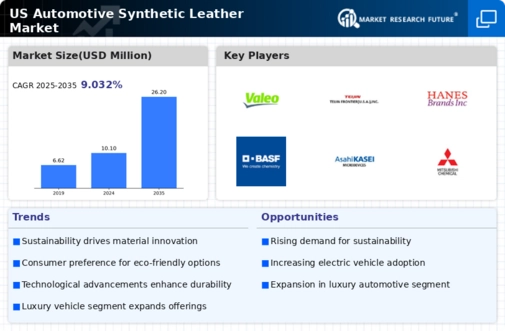The competitive insights of the US Automotive Synthetic Leather Market reveal a dynamic landscape characterized by innovation, sustainability, and rapidly shifting customer preferences. As the automotive industry increasingly emphasizes the importance of eco-friendliness and reducing carbon footprints, synthetic leather has emerged as a viable alternative to traditional leather, offering benefits such as durability and ease of maintenance.
The presence of multiple key players in the market fosters a competitive environment, where companies are constantly striving to enhance their product offerings, invest in research and development, and adopt advanced manufacturing techniques to cater to the unique needs of automotive manufacturers.
This competitive analysis also highlights the challenges posed by fluctuating raw material prices, regulatory developments, and evolving consumer preferences that impact market dynamics. In the context of the US Automotive Synthetic Leather Market, Valeo is recognized for its strong emphasis on innovation and technology.
The company has positioned itself as a leader in the development of high-quality synthetic leather products tailored specifically for the automotive sector. Its presence in the US market is distinguished by a commitment to research and development aimed at creating sustainable solutions that meet the stringent requirements of automotive manufacturers.
Valeo's strengths lie in its robust supply chain management, strong partnerships with automotive stakeholders, and a focus on customer-centric product development that aligns with market trends. The company's leverage of advanced production techniques and its adaptability to changing market demands enhance its competitive edge within the sector.
Teijin, another key player in the US Automotive Synthetic Leather Market, has established itself through a diverse range of innovative products and services aimed at the automotive industry. Specializing in advanced polymer materials and synthetic textiles, Teijin has developed high-performance synthetic leather options that are lightweight, durable, and environmentally sustainable.
Its market presence in the US is marked by a strategic focus on mergers and acquisitions that have bolstered its capabilities and product offerings. Teijin's strengths are further enhanced by its commitment to sustainability, aligning with the growing demand in the automotive sector for eco-friendly materials.
The company has also engaged in joint ventures and partnerships that allow it to better serve the needs of the US automotive market, reinforcing its competitive stance while expanding its reach within the industry.




















Leave a Comment